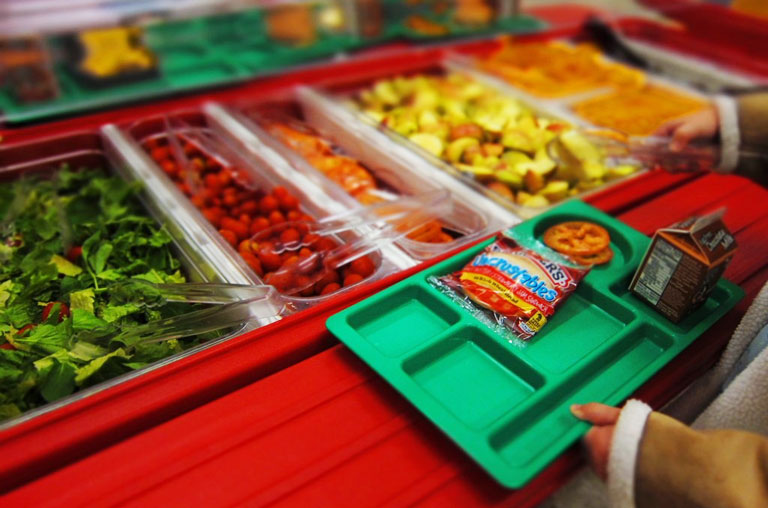A recent article, published in the New England Journal of Medicine, highlights how the COVID-19 pandemic has increased food insecurity for low-income children in the United States. In the US, school-based food programs provide food for over 35 million children daily, and many of these programs have been interrupted due to prolonged school closures.
“Meals and snacks from schools or childcare centers fulfill up to two-thirds of children’s daily nutritional needs and are generally healthier than those brought from home. The short-term health effects of missed meals include fatigue and reduced immune response, which increase the risk of contracting communicable diseases,” the authors, lead by Caroline Dunn at the Harvard T.H. Chan School of Public Health, writes.

Closures and confinement introduced by the COVID-19 global pandemic continue to put stress on populations worldwide. While the full effects of the pandemic have yet to be seen, researchers are beginning to prepare for the impacts on psychological wellbeing. Following the large-scale school closures, children and parents face a new reality of home confinement. While schools traditionally serve as a place of learning, for some children and adolescents, they often provide the bulk of their daily nutrition.
Initially, the US Department of Agriculture (USDA) did not mandate that schools offer food service during COVID-19 school closures. “Instead” explain Dunn and colleagues, “local education authorities (such as school superintendents and school boards) are being permitted to apply approaches from the USDA’s summer feeding programs and have been ‘encouraged to ensure that the needs of low-income children are met during extended school dismissals.'”
However, and Dunn explains, many schools across the US have limited experience running summer food programs. Given this unprecedented situation, guidelines are being put together by local governments and schools that, although innovative, may not ensure food is distributed equitable or be sustainable for prolonged school closures.
As responsibility has shifted away from the National School Lunch Program during school closures, The Families First Coronavirus Response Act allocates funds to support the state level Supplemental Nutrition Assistance Program (SNAP), which, although more flexible for families, places fewer limitations on allowable food purchases and less enforced nutritional guidelines for children. However, the researchers raise concerns that not all students who typically receive lunch at school will be eligible to receive food through this program.
“The COVID-19 pandemic highlights the need for policy-based solutions that ensure food security for millions of American children. Whereas means-tested programs such as SNAP have traditionally received bipartisan support, recent efforts to protect access to this program have been met with substantial partisan opposition,” the authors write. “The current situation is made more tenuous by proposed changes to SNAP that could reduce or eliminate benefits for more than 1 million households with children, such as a proposed rule to limit broad-based categorical eligibility.”
In addition, Dunn and colleagues highlight the increased vulnerability placed on immigrant families during the COVID-19 pandemic:
“Changes to the ‘public charge’ rule went into effect in February 2020. These changes could now deny a path to citizenship for people who use public benefits such as SNAP, which will probably discourage documented immigrant families from obtaining access to emergency provisions, leaving them increasingly vulnerable during the COVID-19 pandemic.”
Dunn and colleagues offer preliminary suggestions to address food insecurity for children in the US:
- Centralize and widely distribute information about schools and school districts providing meals during school closure.
- Decrease social exposures and reduce the time and transportation burden for families by providing multiple days’ worth of meals, allowing for drive-through meal pickup (when reasonable), or coordinating meal delivery.
- Extend emergency benefits to caregivers of children in child care facilities participating in the Child and Adult Care Food Program, and authorize use into periods beyond the COVID-19 response, such as summer months or other emergencies.
- Codify efforts to expand Supplemental Nutrition Assistance Program access and benefits during future pandemics.
- Examine and amend policies that reduce or deter participation in the nutrition safety net (e.g., the public charge rule).
The authors conclude:
“As we grapple with COVID-19, it’s critical to ensure that the nutritional needs of vulnerable children are met in order to avoid exacerbating disparities in health and educational attainment for years to come. We should examine in real-time the strategies being used, acknowledge the broader political landscape in which they’re being implemented, and improve our ability to adapt how, when, and where we provide nutritional support to children.”
More information about SNAP programs in the US can be found here: SNAP.
****
Dunn, C. G., Kenney, E., Fleischhacker, S. E., & Bleich, S. N. (2020). Feeding Low-Income Children during the COVID-19 Pandemic. New England Journal of Medicine. (Link)















Sweden as part of their welfare system provides lunches to primary and secondary kids.
And the lunches are required to be nutrient dense.
How wonderful is that? I wish Canada would follow this example.
Countries are stuck now, not knowing where millions of dollars will come from,
because they can’t figure out that if you have systems like psychiatry inventing
sickness labels, promoting the idea about a head sickness, and provides chemicals that
are dangerous to anyone and everyone, and electricity put into people’s brains,
and the resulting homelessness or inability to work, that it will result in footing big bills
that no one can pay.
Then these same governments extend that chemical warfare to kids.
So yes, we need meals for kids, and we need a strict mandate that IF the asses of psychiatry are allowed to roam free, unlike other criminals, that at the minimum they get their grubby greedy hands off children.
If we don’t provide for kids now, we will provide later.
Report comment
Antipsychotics and psychotropic drugs worsen respiratory health. The drugs increase pneumonia by 2-3.5 times. They increase respiratory deaths. Reports are that the Coronavirus is hitting those who take these drugs harder than other people. So some of the virus deaths will be because they people were taking these psychotropic drugs.
Report comment